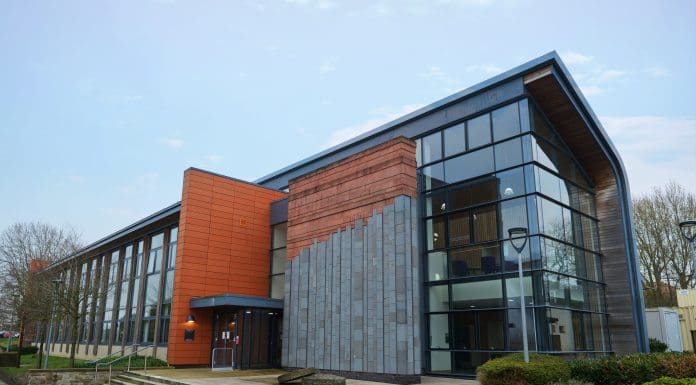£1.7M geothermal ‘living lab’ project at BGS HQ breaks ground

This post was originally published on this site

28 boreholes will be drilled to a depth of 225m to access geothermal energy and enable the British Geological Survey (BGS) to decarbonise its headquarters campus in Rushcliffe, Nottinghamshire.
BGS said the project will save 30 tonnes of carbon dioxide equivalent each year and would reduce the organisation’s heating bill.
The living lab forms part of BGS’s Keyworth campus decarbonisations and includes the removal of gas boilers. The boreholes will feed heat pumps and the pumps will heat two buildings where more than 400 staff work including tenants and non-BGS staff.
Cenergist is the main civils contractor and Pick Everard provided the initial designs.
The £1.7M funding is mainly sourced from the Natural Environmental Research Council (NERC) with a further contribution from the government’s public sector decarbonisation scheme. The scheme is run by the Department for Energy Security and Net Zero and delivered by Salix Finance.
BGS said the heating system will feature “advanced monitoring, which will assess the running costs and efficiency of the heat pumps and provide a case study for other organisations,” that are considering a switch from fossil fuel boilers to heat pumps.
It will be a ‘living laboratory’ because the BGS is deploying sensors in the boreholes and buildings and data gathered in real-time will be used to help improve the public’s understanding of ground-source heat pumps.
BGS will also be taking rock samples from its site to get a better understanding of the flow of heat and water underground. It said the geology of the site at Keyworth is similar enough to geology in other parts of the UK that the information gathered and analysed will be useful for other similar projects.
The living lab project is part of a wider project to help achieve UK Research and Innovation (UKRI)’s aim of reaching net zero by 2040. BGS installed 1000 solar panels above its car park in 2022.
Cenergist head of commercial projects Steve Wilkinson said: “Cenergist are proud to be supporting the British Geological Survey in their plans to achieve net zero by 2040.
“Our solution for this site will provide modernised futureproof low carbon heating and hot water systems to these two buildings, significantly reducing carbon emissions.”
BGS senior engineering and geothermal geologist David Boon said: “Geothermal energy is heat that naturally occurs under the ground and is available 24/7 across the UK.
“This project will demonstrate the deployment of ground-source heat pump technology to decarbonise existing buildings across the public sector estate.”
BGS head of estates and facilities Daniel Crow said: “This exciting project gives us the opportunity to blend our observation of the subsurface with leading low-carbon heating.
“The drilling and heat pump installation is due to last around three months.”
Salix director of programmes Ian Rodger said: “We are delighted to work with the British Geological Survey on this fascinating project.
Rodger said the technology and innovation planned at the site “is hugely exciting and the impact this will have on reducing carbon emissions is inspiring.”
NERC senior environment manager Mike Potter said: “This inspiring project to decarbonise heat at the BGS Keyworth campus will reduce our reliance on fossil fuels.
“This is the first geothermal heat pump system to be installed on the UKRI estate and will support our journey to net zero in 2040.”
BGS invited local MP Ruth Edwards to attend the project launch.
Member of Parliament for Rushcliffe Ruth Edwards said: “I was really honoured to be asked to break ground on the new geothermal heat pump at the British Geological Survey in Keyworth.
“This is a hugely exciting opportunity to help decarbonise the public sector estate.
“I’m thrilled that we are trialling the technology here in Rushcliffe and that the data generated by the trial will be used to inform other projects around the country.”
Like what you’ve read? To receive New Civil Engineer’s daily and weekly newsletters click here.





Responses